Enhance your curriculum by addressing the QAA Guidance on skills for your subject, and incorporating the QAA (2018) Guidance on Enterprise and Entrepreneurship.
All the materials contained in this section are suitable for extra curricula activities, such as Summer Schools, Boot Camps and Workshops.
Like the other materials held within the ETCToolkit, they are mapped to QAA (2012) Guidance mapping so that you can select appropriate materials to help your activities deliver specific enterprise themes/outcomes.
The following ETC tools can help you to deliver these skills in the curriculum
These guides have been selected to build QAA (2018) enterprise skills in your teaching.
Group Size
?
1.) Small group (teams of 4-6)
2.) Individual Task
3.) Large Group
4.) Any
Large Group
Learning Environment
?
1.) Lecture Theatre
2.) Presentation Space
3.) Carousel Tables (small working group)
4.) Any
5.) Outside
6.) Special
Any
QAA Enterprise Theme(s)
?
1.) Creativity and Innovation
2.) Opportunity recognition, creation and evaluation
3.) Decision making supported by critical analysis and judgement
4.) Implementation of ideas through leadership and management
5.) Reflection and Action
6.) Interpersonal Skills
7.) Communication and Strategy
8.) Digital and Data Skills
3Decision making supported by critical analysis and judgement
5Reflection and Action
6Interpersonal Skills
This quick and immediate task works well as at the start of a topic or programme as it can be an effective icebreaker. However it can be used at the end of a programme of study or to close practical learning to gauge levels of confidence in the learning and pull out key points.
All you need is a corridor or open space in your teaching room so that you can encourage all your learners into a line. However this task can be noisy (lots of discussion) so you may need to accommodate other learners within your building/learning space; but it is also possible to do this outside in an open space!
This simple activity requires the learners to move physically and place themselves into a line. Your role as tutor is to declare a challenge or task – or introduce the topic (or restate if revision) and then ask the students to put themselves in a line, based on their understanding of the topic/challenge. Present yourself as the “head of the queue” as the expert and invite them to line up.
They will have to navigate their understanding of the challenge or negotiate with each other as to who has displayed better skills or knowledge in the past or during the programme, or who has more experience or understanding of the project or topic.
Typically they will bunch at the back, far away from you but given time and the instruction that you need a line in front of you, they will reorder into a line.
You can invite them to talk to those next to them to ensure that they are in the right order and move up or down as appropriate.
Give this quick task time to play out, as the discussion between participants needs to deepen, particularly if you are using this as an icebreaker. However it can also work as a confidence boost when used as a revision tool as students encourage each other to move up and recall their successes and prowess during the programme of study.
Once the group has settled, as them the following:
You can ask (some of) these questions and then allow them to talk to those next to them before taking full group feedback or you can seek responses from them as they stand before you. It is also possible to ask a different question of each of them and ensure that everyone in the group has spoken in this task.
Ensure that you reflect with the group on their decision making related to subject knowledge/expertise/practical experience but also see if internal personal skills or sharing knowledge (communication) improves your ‘ranking’ in this way. End this quick session by releasing them back to their seats but also reminding them that all they have displayed in their ranking is their confidence rather than actual ability and therefore they are now able to create their “real” score or position through their own practice/effort.
Whilst the students have a short amount of time to find out what they need to know from each other, they have to use their interpersonal skills to ask the right questions. Some will be use a factual basis (previous scores obtained or exam results) others will judge on wider experience and knowledge. Itis important to reflect with the full group what they used to make these judgments and whether they could have taken other elements into account. Explore the important of communication and knowledge in achieving goals and encourage the students to consider their own action plan at the end. It is possible to determine a skill “take-away” or challenge to improve their “ranking” and this will deepen their understanding of skills in relation to knowledge.
None
N/A
Group Size
?
1.) Small group (teams of 4-6)
2.) Individual Task
3.) Large Group
4.) Any
Any
Learning Environment
?
1.) Lecture Theatre
2.) Presentation Space
3.) Carousel Tables (small working group)
4.) Any
5.) Outside
6.) Special
Any
QAA Enterprise Theme(s)
?
1.) Creativity and Innovation
2.) Opportunity recognition, creation and evaluation
3.) Decision making supported by critical analysis and judgement
4.) Implementation of ideas through leadership and management
5.) Reflection and Action
6.) Interpersonal Skills
7.) Communication and Strategy
8.) Digital and Data Skills
5Reflection and Action
6Interpersonal Skills
7Communication and Strategy
Participants gain confidence in responding to questioning under pressure. They may importantly also learn that they need to ‘act’ differently with different stakeholders. They learn quickly to adapt to others’ point of view.
This is a group exercise. Members of the group in turn are put in the ‘Hot Seat’ to respond to intensive questioning from other group members. Traditionally, this ‘Hot Seating’ technique is used by actors to help them identify with the character they are playing. It is used in entrepreneurship education to enable participants to get inside the culture and values of stakeholders with whom they might have to deal. But it can also be used for intensive questioning of an individual’s own personal aims, objectives and plans including business plans. Other participant’s (the group) act as interrogators in this exercise; note: it can be useful to agree ground rules as what is appropriate in terms of questioning and approach within this task.
The hot seat itself is in the middle of a semi-circle of chairs. The person in the ‘Hot Seat’ can be himself/herself or represent a client or stakeholder. Dependent upon the role, questions fired rapidly may relate to personal issues; business/organisational problems or community activities (part of ground rules).
Example Hot Seat: Business/plan/idea
The individual is surrounded by those role playing different stakeholders which the plan might need to convince. The aim is to create recognition that the plan will be seen very differently by very different stakeholders. Interrogators may, for example, play the roles of bankers, venture capitalists, family, local government officials offering grants; a potential large customer who will be judging whether to include the client on a buying list or a major potential supplier who may be asked for credit.
Other participants can then be similarly hot seated. At the end of the hot seating there can be a review of what has been learned about the business plan as a relationship management instrument and how it might be best developed to meet different needs.
Example Hot Seat: different stakeholders
Using the same focus of the business plan; hot seater’s, in turn, can be asked to play the roles of different stakeholders, as above, and are quizzed about what they are looking for and why?
Example Hot Seating: on a problem
The technique can be used to role-play individuals from a case study with the aim of creating lively personalised discussion of major points for learning from the case. It can also be used to focus discussion on how to deal with a particular problem set out in a simple brief.
This is an exercise in thinking and responding under pressure. It also is designed to stimulate understanding of relationship management and the value of thinking empathetically. It can be used to throw light on the ‘organisational cultures’ of different stakeholders that make them see the same things in different ways.
A Compendium of Pedagogies for Teaching Entrepreneurship. Professor Alan Gibb and Alison Price - (PDF)
Group Size
?
1.) Small group (teams of 4-6)
2.) Individual Task
3.) Large Group
4.) Any
Any
Learning Environment
?
1.) Lecture Theatre
2.) Presentation Space
3.) Carousel Tables (small working group)
4.) Any
5.) Outside
6.) Special
Any
QAA Enterprise Theme(s)
?
1.) Creativity and Innovation
2.) Opportunity recognition, creation and evaluation
3.) Decision making supported by critical analysis and judgement
4.) Implementation of ideas through leadership and management
5.) Reflection and Action
6.) Interpersonal Skills
7.) Communication and Strategy
8.) Digital and Data Skills
2Opportunity recognition‚ creation and evaluation
6Interpersonal Skills
Ideas are stimulated by exposure to experience. The animation arising from this approach creates stimulation to the affective and co native aspects of learning. Contacts are made and barriers to external relationship development are broken down.
A Panel is a means of fronting a debate or forming the basis for a process of questioning or collecting opinion/experience on certain issues, problems or opportunities. The Panel may be composed of 'externals' or may be used as an internal 'review' group for a particular issue. It is often also used as an alternative to inviting presentations from external speakers.
Panels are often misused in that they become a vehicle for a series of speeches by panel members in response to a number of questions asked by the chair or harvested from the audience; however panels can be used in different ways.
The 'Expert Panel' is used to provide comment on a particular issue about which the panel have relevant experience. Here, the optimum format is where the panel very briefly addresses questions from the audience collected either beforehand or spontaneously. Engagement of the audience in the debate is important. The chairperson's role in stimulating audience participation, provoking cross-panel debate, keeping comments short, summarising and ensuring that the debate is to the point is critical. The panel should be carefully chosen to bring different perspectives to the theme. For example in debating issues concerning the 'entrepreneurial university', a panel might have a Vice Chancellor, an articulate student perhaps representing a student body, an entrepreneur with some experience of interacting with a university, a representative of a regional development authority or local government and someone from the Department of Education.
An Expert Panel can also be used with small groups to evaluate or comment upon the ideas, proposals and plans of participants.
Participant Panels can be formed to role-play stakeholders or simply to comment upon the work of other participants, individual or groups; for example, to advice on marketing plans.
A Representative Panel, for example, a small group of entrepreneurs from a particular sector, or a group sharing a common environment or experience (for example all having taken up external equity) can be used to explore the experience via a process of questioning by participants (often after briefing from programme input).
The emphasis is upon exposure to tacit learning, enabling assessment of 'how things are seen and done' in the world of practice. If chaired properly it can also provide a strong measure of learning by interaction. It can also provide a vehicle for testing out concepts in practice.
Group Size
?
1.) Small group (teams of 4-6)
2.) Individual Task
3.) Large Group
4.) Any
Large Group
Learning Environment
?
1.) Lecture Theatre
2.) Presentation Space
3.) Carousel Tables (small working group)
4.) Any
5.) Outside
6.) Special
Special
QAA Enterprise Theme(s)
?
1.) Creativity and Innovation
2.) Opportunity recognition, creation and evaluation
3.) Decision making supported by critical analysis and judgement
4.) Implementation of ideas through leadership and management
5.) Reflection and Action
6.) Interpersonal Skills
7.) Communication and Strategy
8.) Digital and Data Skills
2Opportunity recognition‚ creation and evaluation
3Decision making supported by critical analysis and judgement
4Implementation of ideas through leadership and management
Students should be able to:
With the support of alumni who engage through social media (facebook; twitter etc) an/or Skype, students are given incremental weekly instruction that builds into an overall assignment. This interactivity means that deadlines can changed and information updated, often in response to newsworthy or other high profile influences and the students need to adapt throughout the module. (The assignment usually mirrors an actual assignment undertaken professionally by an Alumni professional). The project is designed to precede later work where the students will engage with real clients, so as to better enable them to respond proactively to change.
Activity
This activity is undertaken in semester 1 of a second year course of study (15 weeks – 2.5 hour sessions with anticipated 2.5 hours private study per week) and runs across all Visual Communication and Design courses. Each course's relevance is ensured as the framework can be adapted to specific study areas and alumni inform the actual project – so as to ensure relevance and to maintain student motivation (See: Continuous Conceptual Review Model). The sample offered here is for two cohorts (approximately 50 students) from the film and media production courses and from the Advertising and Brand Management course – who will subsequently engage in an interdisciplinary module.
The following provides an outline of the activity as delivered to these disciplines, and was first introduced in 1995 following alumni feedback on the value of their educational experiences. Other disciplines use their own alumni and realistic contexts.
Week 1
Students expect the lecturer to lead the class, but an unannounced stranger is brought in (alumni - in person or via skype) who asks the group about their career aspirations and challenges their understanding of the world of work. He or she explains their busy lifestyle and asks them to quickly help him or her with a problem they have – how to visualise a brand for a new academy of creativity, but explain that they have to go and leave them to it. Normally 90-95 per cent of responses include a light bulb.
Week 2
Student's have been discussing the individual and although not told, want to question the alumni about their work (curiosity based learning). The alumni,still in a rush, starts to explain that the headmaster for this new school will be Sir Humphrey Davy... then the connection is lost. Quick internet searches reveal that this is a historical project, as Sir Humphry Davy lived in 1778 – 1829 and that his work preceded the invention of the light bulb. Past work is discarded (with occasional moans and groans) and new research starts into historical images that represented creativity - prior to the invention of the light bulb. New / alternative ideas start to emerge.
Towards the end of the session the alumni reconnects / re-enters the room and takes questions about their work as a freelance storyboard writer for major TV companies. Scripts are discussed and student interest gained – a promise to see a script is made by the alumni.
Week 3
An outline of a TV script is presented to students by the alumni. They or another alumni start to explain how camera angles and specialist instructions such as close ups or super close ups need to be incorporated in the storyboards. Examples from well know TV programmes or Films are shown when possible. With support from the alumni, students attempt to develop a storyboard through acting out the script and noting important aspects such as emotional engagement. Identification of the brand is central to the story line.
Week 4
The alumni explains that he or she has just met the producer, who is happy for them to see other scripts for later episodes. Episode two has the main character Davy waking up in the future and looking at a barren landscape, one which is littered with light bulbs - which is now a thing of the past. The alumni explains that their brand has to survive the passage of time and that it has to be recognisable in the year 2020. Research into potential future understanding of creativity commences and students envisage / storyboard a potential future scenario based on the script.
Week 5
The alumni / staff set up an opportunity for the students to pitch their ideas to the alumni. They have an hour to prepare a presentation and are requested to discuss and argue a minimum of three ideas. This was unexpected. After 20 -25 minutes the alumni asks them to limit their presentation to one or two minutes, so that he / she can hear them all. Students are asked at random to present. Time may run out and alumni ask students to make a pdf version to email (via staff).
Week 6
The alumni explains the future direction of the time travelling Davy, and introduces the idea that he may meet aliens in his travels. Some students have already discovered Davy claimed this through their research. The task now is to create a pitch as to why aliens would find the brand design that they are developing to be credible.
Weeks 7–9
Students develop their storyboards and at least 3 brand ideas in the sessions. More in depth research is undertaken and initial concepts re-evaluated anditeratively developed. Arguments for the solutions are mapped and explained as reflective mind maps – so as to illustrate the thinking journey.
Week 10
With 2 or more alumni present or available via Skype, students are asked to consider how this kind of work could be best assessed and who should assess it? Using a pro forma, students suggest how their could be meaningfully evaluated. Through discussion, research, and assisted by appropriate lines of questioning by the educator and alumni, the idea of flexibility, adaptability and the requirement for multiple solutions emerge. Students come to realisethat their response to change is a key factor and that when faced with incomplete data (QAA, 23 states "students can be required to work with incomplete information or information that is incrementally offered after a review of their initial findings"). As multiple and responsive outcomes are the most important aspect, the theory of divergent production is introduced, i.e. more solution developing capabilities, many alternative solutions that respond to change, plus the value of distinctiveness of ideas (similar solutions being less creative than distinctly different ones).
Week 11–13
Students develop their ideas further, in the knowledge that the alumni will be commenting and advising the educator, and that they will be assessed on the distinctiveness of a range of ideas that relate to the assignment given to them by the alumni. These will be evidenced by charts that illustrate the critical elements of their research and how the research informed their solutions. In simple terms, the more divergent the thinking the more complex the charts, hence students can easily recognize the range of solution development that has taken place in a clear and transparent manner.
Week 14–15
Pitches take place and the alumni adds their thoughts and comments. Assessment is based on the range of alternative ideas, the divergence of alternative ideas and their ability to be used flexibly in the scenarios described in the scripts supplied by the alumni.
Note: later, in the next semester's module, the process continues and approximately 5 weeks into the projects each class will be provided with a theory session on brain functionality and how these kinds of activities enhance 'aha' moments of creative discovery (See: Penaluna, A., Penaluna, K and Diego, I. (2014) The role of education in enterprising creativity. In Sternberg R and Krauss, G. (2014) Handbook of Research on Entrepreneurship and Creativity. Cheltenham / Massachusetts: Edward Elgar). Thus practice informs personal theory development and theory follows practice, "reflective practice enables students to 'join the dots' of past experiences and perceptions" (QAA, 14).
The assignment is constructively aligned (Biggs, 2003) as it enables students to demonstrate their skills and responses in meaningful and relevant (to their studies) scenarios that engage true to life experiences of alumni – who are partners in the process / most of whom have now experienced it for themselves in their own education and are familiar with the concepts.
Of interest is that the assessment strategy is often new conceptually and structurally, but through debate and discussion (week 10) the students feel engaged and very aware of the goals – which are not as they first perceived.
The assignment also leads into later QAA areas, for example they learn to "robustly justify their decision making processes" (QAA, 17) and includes "pitches to peers and expert advisors" (QAA, 23) that involves "feedback from different viewpoints" (QAA, 26).
Moreover, aspects of decision making supported by critical analysis and judgement (QAA, 19) can be evidenced in this and later assignments based on the same approach. Specifically, the assignment discussed here adopts the following QAA (19) guidance on delivery approaches:
Open plan and flexible working environments suited to enactments and pitching – ideally simulated professional design studio with access to online resources
Access to, and ongoing (committed) virtual engagement by appropriate alumni – determine brief/project
Pens and software utilised in storyboard development and brand evolution.
Penaluna, A., Penaluna, K and Diego, I. (2014) The role of education in enterprising creativity. In Sternberg R and Krauss, G. (2014) Handbook of Research on Entrepreneurship and Creativity. Cheltenham / Massachusetts: Edward Elgar).
Scott, J., Penaluna, A., Thompson, J & Brooksbank, D. Experiential entrepreneurship education: Effectiveness and learning outcomes. International Journal of Entrepreneurial Behaviour and Research (Forthcoming)
Jones, C., Penaluna, A., Matlay, H., Penaluna, K. Discovering the Soul of Enterprise Education. Education +Training, Emerald Publishing (Forthcoming)
Penaluna, K., Penaluna, A., Jones, C. and Matlay, H. (2014) 'When did you last predict a good idea?: Exploring the case of assessing creativity through learning outcomes', Industry and Higher Education, Vol.8, No.6, December 2014: 399 - 410
Penaluna, A., Coates J. and Penaluna K., (2011) Creativity-Based Assessment and Neural Understandings: A Discussion and Case Study Analysis. Education + Training, Emerald Publishing, Volume 52, Issue 8/9, pp. 660 - 678
If you would like to have your How to Guide featured, please download the template and email the completed version to hello@etctoolkit.org.uk.
We have produced a guidance sheet which will assist you in completing the How to Guide.
If you have any questions regarding completing the template, please Contact Us.
Group Size
?
1.) Small group (teams of 4-6)
2.) Individual Task
3.) Large Group
4.) Any
Small group (teams of 4-6), Large Group
Learning Environment
?
1.) Lecture Theatre
2.) Presentation Space
3.) Carousel Tables (small working group)
4.) Any
5.) Outside
6.) Special
Carousel Tables (small working group)
QAA Enterprise Theme(s)
?
1.) Creativity and Innovation
2.) Opportunity recognition, creation and evaluation
3.) Decision making supported by critical analysis and judgement
4.) Implementation of ideas through leadership and management
5.) Reflection and Action
6.) Interpersonal Skills
7.) Communication and Strategy
8.) Digital and Data Skills
1Creativity and Innovation
2Opportunity recognition‚ creation and evaluation
3Decision making supported by critical analysis and judgement
6Interpersonal Skills
To develop an interdisciplinary network of exchange which promotes innovation, design thinking, new-product development. Bringing together a students from across the University, who value innovative thinking, ideas generation and interdisciplinary working as part of their student experience.
Interdisciplinary has been recognised as a key contributor in solving complex global social problems (BIS, 2009; 2009a; DIUS, 2008, QAA 2012). It therefore follows that graduates as societies leaders with a genuine interest in making the world a better place must have the ability and confidence to work across disciplines. In today’s global economy and in society as a whole, we are faced with many complex challenges which require new ways of working and graduates need to be prepared for this through the integration of interdisciplinary working within their under graduate (UG) curriculum.
The 24 hour design challenge: Second year students from across 3 schools within the university were invited to register for this event, places were limited to 40 students, a maximum on 10 students from a single discipline area.
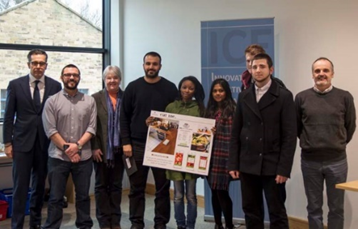
The impact on learning was evident through the student feedback, we categories it into skill development, Collaborative working, Entrepreneurial development.
“There is never a stop-point in learning – there is always room for more”. (2015 student)
“Competing in this design challenge was a thoroughly enjoyable process. As an engineer, it is important that I develop the ability to work with multiple disciplines and in the 24 hours we were given I have been given a massive insight into how completely separate skill sets can come together to generate an idea. I also find it incredible that after only a day, I came away with a team that I had formed a friendship with and now have an insight into demonstrating an idea to someone who has the means to make it a reality. Overall I cannot fault the opportunity of taking part and enjoyed every stress inducing minute of it. I would definitely do something similar again.” (2014 24 hour design challenge).
Skill-development:
“....in the 24 hours we were given I have been given a massive insight into how completely separate skill sets can come together to generate an idea” (student quote, 2013 challenge).
“It was an enjoyable challenge, bringing in different skills we have learnt throughout our time here so far. I would defiantly recommend it to anyone and do it again” (student quote, 2013 challenge).
“…enjoyed every stress-inducing minute of it. I would definitely do something similar again” (student quote, 2013 challenge).
“I learned a lot from my peers in my team and this experiment will benefit me in future group projects” (student quote, 2014 challenge).
Collaborative working:
“....I really enjoined the challenge and it was good to start viewing things from different discipline angles” (student quote, 2013 challenge).
“This design challenge was great. I love working with all of my team who were from different specialisms” (student quote, 2013 challenge).
“It has shown me what some of my lecture have been trying to tell us which is that collaboration and working with people from different specialisms is when design can really take off and become exciting” (student quote, 2013 challenge).
“I really enjoyed the 24 hour challenge as I valued meeting new people and exploring different areas of study” (student quote, 2014 challenge).
“It was really helpful to speak to the different tutors and pick their brains about our ideas, as I would never normally come into contact with tutors from these courses” (student quote, 2014 challenge).
Entrepreneurial development:
“The challenge has made me even more interested in working with people I don’t know and also has inspired me to think about business ideas for my future career” (student quote, 2013 challenge).
“It was a great experience, thank-you! It is a great insight to the business world that we are entering” (student quote, 2013 challenge)
“Overall it was a great experience and I now have contacts and friends on completely different courses to me who I will no doubt be calling on for help on future projects as well as the one we started” (student quote, 2014 challenge).
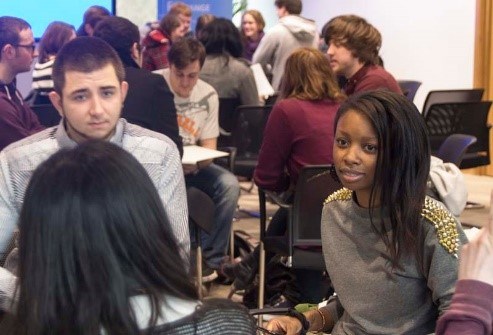
Comment from external Judge: “Judging the 24-hour design challenge was a pleasure and revealed an impressive arsenal of talent the University of Huddersfield has amongst the students. Each multi-disciplined team presented well thought out and researched concepts which impressed the judging panel and stimulated much debate. Being spoilt for choice meant the pressure was put back on the panel when it came to us choosing a winner. In my experience, great ideas occur when a creative person or team is constrained by time and/or budget. When placed under pressure, right brain instinct coupled with pragmatic decision making, causes inventive and exciting concepts and solutions. Events like the 24hr Design Challenge are a great example of where you'll see this in action.” (David Bailey Creative Director UX&D, BBC Future Media).
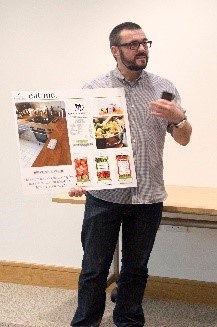
The learning is not within the task objective, but within the team process, networking and cross-fertilization of skills and often the desire to complete the task can mask the transferable learning that has been gained. It is therefore key, that once the discussion of the challenge itself is complete, that the de-brief encourage the teams to explore the skill development within the task and team work itself. As a facilitator, it is important that you allow the teams to explore their team process and find the learning within that. Within the dragon’s den the teams are asked to reflect on this experience.
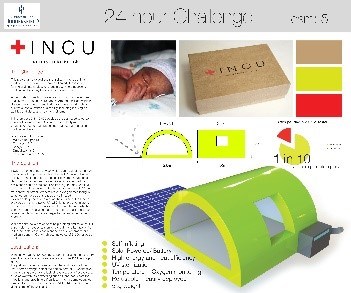
BIS (2009). Skills for growth, the national skills strategy, Department for Business Innovation and Skills. Nov 2009 (pp. 1-78). Retrieved from https://www.gov.uk/government/uploads/system/uploads/attachment_data/file/228764/7641.pdf
BIS (2009a). Higher ambitions: The future of Universities in a knowledge economy, Department for Business Innovation and Skills. (pp.1-78).
DIUS (2008). A new ‘University Challenge’. Department for Innovation, Universities and Skills. (1-20).
QAA (2012). Enterprise and entrepreneurship education: Guidance for UK higher education providers
September 2012. Quality Assurance Agency. Retrieved from http://www.qaa.ac.uk/en/Publications/Documents/enterprise-entrepreneurship-guidance.pdf Page 1-32
Contact details: Dr E. J. Power, University of Huddersfield
Group Size
?
1.) Small group (teams of 4-6)
2.) Individual Task
3.) Large Group
4.) Any
Small group (teams of 4-6)
Learning Environment
?
1.) Lecture Theatre
2.) Presentation Space
3.) Carousel Tables (small working group)
4.) Any
5.) Outside
6.) Special
Special
QAA Enterprise Theme(s)
?
1.) Creativity and Innovation
2.) Opportunity recognition, creation and evaluation
3.) Decision making supported by critical analysis and judgement
4.) Implementation of ideas through leadership and management
5.) Reflection and Action
6.) Interpersonal Skills
7.) Communication and Strategy
8.) Digital and Data Skills
1Creativity and Innovation
2Opportunity recognition‚ creation and evaluation
3Decision making supported by critical analysis and judgement
4Implementation of ideas through leadership and management
5Reflection and Action
6Interpersonal Skills
7Communication and Strategy
In the summer of 2015, four Hairdressing Students, from NE Wales Based FE College Coleg Cambria’s Deeside Site, were crowed winners of Barclays ‘Built for Business’: a UK-wide enterprise competition, targeting Level 1, 2 and 3 students, run as part of Barclays Money Skills ‘Prepare for Work’ programme.
The team was one of only five short-listed from across the UK to compete in the finals, which were held in Barclays’ head offices in Canary Wharf, London.
During their trip, the innovative students had to pitch an original business idea to a panel of expert judges including Chris Hearn, Head of Education at Barclays, and Sylvia Perrins, CEO of the National Skills Academy for Financial Services.
Resources and information supporting this activity can be found through the Barclays Money Skills ‘Prepare for Work’ programme.
The competition invited students to work in groups (of between 2 and 4 people), to think of a new, innovative and sustainable business idea. The students were given an imaginary budget (of £10,000) and had to work as a team to produce a plan and pitch for how they would get their idea off the ground.
The winning Coleg Cambria Hairdressing students decided on an idea for a business called ‘Dolly Parting’: providing a full salon service and experience to people with disabilities, to the elderly, and to their carers and support workers.
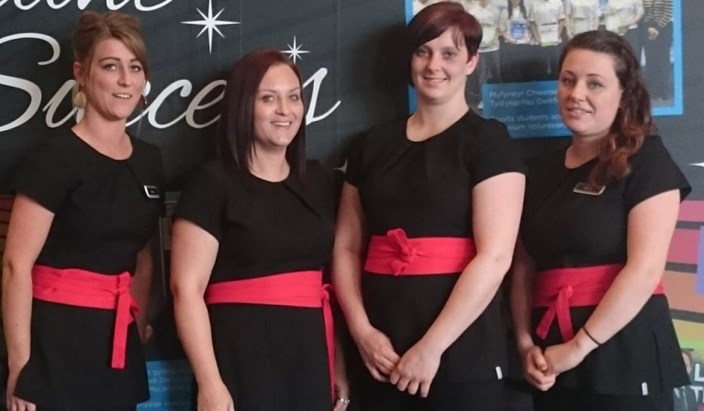
Figure 1:The winning 'Dolly Parting' Students
Lynn Williams, Enterprise Lecturer at Coleg Cambria;
“We are delighted that the Coleg Cambria team won this highly esteemed prize. Competitions like these provide a great opportunity for our students to both develop and showcase their entrepreneurial skills. Dolly Parting’s business idea was every bit as innovative as their team name!”
Lynn Williams, Enterprise Lecturer at Coleg Cambria;
“All of the learners involved in the Built for Business competition have increased their skills in many areas, including communication, teamwork, numeracy, sustainability, problem solving and creativity. The team that won (Dolly Parting) showed a high standard of all of these skills, and we’re extremely proud of them, and of all the learners who took part in the challenge.”
Kelly Meredith, Dolly Parting team member;
“This has given us a lot more confidence, and ideas of what we can achieve after we have finished college.”
Barclays Money Skills ‘Prepare for Work’ resources > http://www.barclaysmoneyskills.com/Information/Our-projects/Prepare-for-Work.aspx
Group Size
?
1.) Small group (teams of 4-6)
2.) Individual Task
3.) Large Group
4.) Any
Large Group
Learning Environment
?
1.) Lecture Theatre
2.) Presentation Space
3.) Carousel Tables (small working group)
4.) Any
5.) Outside
6.) Special
Presentation Space
QAA Enterprise Theme(s)
?
1.) Creativity and Innovation
2.) Opportunity recognition, creation and evaluation
3.) Decision making supported by critical analysis and judgement
4.) Implementation of ideas through leadership and management
5.) Reflection and Action
6.) Interpersonal Skills
7.) Communication and Strategy
8.) Digital and Data Skills
1Creativity and Innovation
2Opportunity recognition‚ creation and evaluation
3Decision making supported by critical analysis and judgement
5Reflection and Action
6Interpersonal Skills
In north east Wales a number of criminology students (along with peers from a variety of degree programmes) develop their enterprise skills by engaging with expert guest speakers, facilitated by the Business Entrepreneurship Network.
The Business Entrepreneurship Network for Wrexham and Flintshire is a network of businesses, business support organisations, entrepreneurs and education institutions with a shared interest in supporting individuals (especially young people and those from disadvantaged backgrounds), in developing their confidence, aspirations and abilities, and supporting them through the process of starting up their own businesses.
The network was established by Askar Sheibani, CEO of Comtek Network Systems LTD, and an appointed 'Entrepreneurship Champion' to Welsh Government. In 2014, having been successfully developed in Flintshire, the Network's provision was extended to Wrexham. Speaking at the launch of the Wrexham Network, Mr Sheibani said, "The aim is to increase the number of business start-ups in Wales and this trial in Wrexham will give us a better ideaof how the Flintshire model can be improved and applied in other regions. The Wrexham trial is supported by the Welsh Government and we are confident that the model – which was developed within the community at a grass roots level - will prove to be a practical and innovative way to increase the level of entrepreneurship and business start-ups in Wales."
Amongst the ways in which the Business Entrepreneurship Network supports entrepreneurs, is via fortnightly 'Enterprise Clubs.' These clubs are coordinated in Wrexham by NE Wales based further education institution Coleg Cambria, and feature presentations by invited guest speakers, followed by informal networking.
The use of guest speakers at enterprise clubs has been of tremendous value to learners. The clubs are held at Wrexham Library, a centrally located and publicly accessible venue, and are open to students, graduates and members of the public free of charge.
A number of regular attendees are current NE Wales based undergraduate students, from a wide-variety of degree programmes. Attendees range from those setting up their own businesses, to students looking to develop their networks and skills for employment, to those simply wishing to develop their confidence and find out more.
Planning Guest Speaker Sessions
There is no budget to facilitate guest speakers to the Enterprise Club. As such, appropriate speakers are identified from a variety of sources, including;
Club members are invited to suggest the topics and themes they would like the club to cover in the coming weeks and months, and speakers are sourced to meet these specific needs, ensuring sessions are always relevant to their audience. Speakers are generally confirmed two weeks prior to a club meeting, allowing for the sessions to be promoted through a club mailing list, through professional networks, through general press release, and through social media.
Facilitating Guest Speaker Sessions
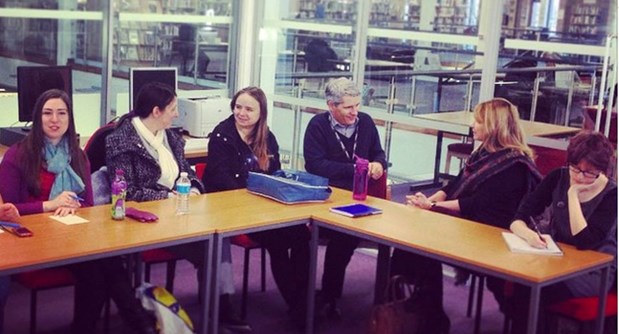
Figure 1. Attendees discussing ideas at the BEN Enterprise Club
Enterprise Club sessions last for 2 hours. The general running order is as follows;
The guest speaker sessions have made a huge impact on the club attendees. The first hand, up-to-date, and relevant knowledge and expertise which speakers have passed on to club members, is directly applicable to the groups of needs and endeavours, and the opportunity to network with speakers and fellow club attendees has led to numerous mentoring relationships and collaborative projects, and allowed members of the group to identify bespoke solutions to their own specific problems.
Approximately 100 unique individuals have participated in the guest speaker sessions to date, with average attendances of 10 participants at each club meeting, and with many new enterprises being launched by club members.
Comments from regular club attendees have included;
"The staff, the entrepreneurs and the members have helped me out a lot and not just with my business. They have boosted my confidence and made me feel like I could really achieve my dreams."
"BEN has helped me a great deal with starting up my business and I have been given so much positive feedback from both mentors and fellow members."
"The BEN Club has allowed me to work with a great mentor and meet great people with passion for business."
With thanks to Lynn Williams, Coleg Cambria – lynn.williams@cambria.ac.uk
Group Size
?
1.) Small group (teams of 4-6)
2.) Individual Task
3.) Large Group
4.) Any
Small group (teams of 4-6)
Learning Environment
?
1.) Lecture Theatre
2.) Presentation Space
3.) Carousel Tables (small working group)
4.) Any
5.) Outside
6.) Special
Special
QAA Enterprise Theme(s)
?
1.) Creativity and Innovation
2.) Opportunity recognition, creation and evaluation
3.) Decision making supported by critical analysis and judgement
4.) Implementation of ideas through leadership and management
5.) Reflection and Action
6.) Interpersonal Skills
7.) Communication and Strategy
8.) Digital and Data Skills
1Creativity and Innovation
2Opportunity recognition‚ creation and evaluation
3Decision making supported by critical analysis and judgement
4Implementation of ideas through leadership and management
5Reflection and Action
6Interpersonal Skills
7Communication and Strategy
•To provide creative industries students with a real-world context in which to apply their skills.
•To provide students with real-world opportunities for creative problem solving.
•To provide students with experience of operating within a high pressure environment.
•To provide students with experience of managing risk, uncertainty, and being responsive to changing parameters.
•To provide students with experience of delivering a project according to strict time and budgetary constraints.
•To provide students with experience of managing a project, from inception to completion.
•To provide opportunities for students to develop their interpersonal skills through working with a variety of stakeholders.
‘HOME’ saw two students studying towards an MA in design practice gain invaluable industry experience, develop their professional skills and networks in a challenging and changeable environment, and put their academic theories into practice in a real world context. It saw numerous art and design students gain experience of working in, exhibiting and selling art, many for the very first time, and it saw a North Wales charity receive a huge boost from the creativity, energy and expertise of students.
This project was initiated as a collaboration between various departments at Glyndwr University (namely, the Students’ Guild, Student Services, and the School of Art, Media and Design), when an opportunity arose to offer a fantastic opportunity to students to develop their enterprise and entrepreneurial skills and awareness, and to support a valuable local charity in the process.
Student Services had been in discussion with NE Wales based charity 'Save the Family’. The charity’s shop (based approximately 12 miles from the main University campus in Mold, NE Wales) was struggling to turn a profit, threatened with immanent closure, and the charity hoped that the expertise of students from the University may be able to help.
Through discussions between Student Services, the Students’ Guild, and School of Art, Media and Design, it was decided that students studying towards an MA in Design Practice would be good candidates for the collaboration, and furthermore, it was known that students from this programme were actively seeking real-world projects to engage with.
With such a large proportion of art, media and design students going on to work in a freelance capacity upon graduation, skills in enterprise and entrepreneurship are essential to their future success, and so all are encouraged to engage in enterprising projects in a variety of ways. This project had the potential to offer students a holistic real-world context in which to apply their academically developed skills, and fit within the existing structure of their Masters programme through the optional modules available (students on this programme are obliged to engage in real-world practice of some shape or form, on which they are assessed).
The project was initiated by way of an informal meeting between the students and key University staff, and all subsequent activity was developed thereafter.
•To provide opportunities for students to develop their communication skills.
•To support the University’s community obligations through giving support to a local charity.
The activity associated with the project extended over a 14 week period. Key elements throughout that period were as follows;
1.Initial Introductions
Through discussions between the charity and University, it was established that MA Design Practice students would be well suited to meet the brief, and two students from that programme were identified who were looking for a project to engage with at that time. A meeting was arranged with these students to discuss the brief (which appealed to them), and to sketch out a broad plan of action going forward. A staff member from Student Services acted as a project contact for students, but the students themselves were given decision making powers with regards the forward direction of the project.
2.Research and Planning (6 weeks approximately)
In this phase, the students visited the charity shop space, met with its volunteers and managers, and conducted their own research, before presenting their conclusions as to why the shop was struggling to remain solvent. They then took these conclusions, and supported by further discussions and research, proposed measures which could be taken to transform the charities fortunes. Namely, they proposed to ‘curate’ the shop, up-cycling goods and giving the shop a ‘boutique’ feel, whilst integrating designated spaces for small workshops, performances and discussions. In line with the charities own objectives and ideals, ‘home’ was taken to be the shops theme. This proposal had to be sold to the shops managers, and amendments and changes agreed upon before the project could be carried forward.
Throughout this period, the University supported the students in a tutoring and mentoring capacity, financially by way of nominal travel and subsistence expenses, and attended meetings with the students and charity representatives on the students’ request, whilst ensuring the students maintained project management control.
3.Installation (2 weeks approximately)
During this period, the shop was closed to the public, and completely redesigned. Students were required to work with the materials provided, and within the budgets set by the charity for this work, with additional materials being offered in kind by the University. Fellow art, media and design students (from various programmes and levels of study) were invited to support this process, by volunteering time, and by offering their own works to either exhibit or sell (all coordinated by the students themselves). Marketing materials for re-launch were produced and disseminated at this time too.
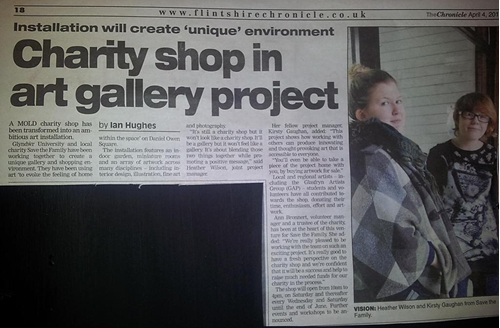
Figure 1. Project PR (Flintshire Chronicle press cutting)
4.Launch
A launch event was held, with invited VIPs, press, charity and University representatives. This presented an opportunity for the students to receive feedback and recognition on their progress to date.
5.Trading (6 weeks approximately)
For the following 6 weeks, the shop was staffed by volunteers and open for businesses. The students made regular visits to the premises, met periodically with the shops managers, and monitored its performance, being responsive to circumstances and implementing changes wherever necessary. Throughout this period, the students continued to blog, market via social, print and digital media, and organise small events within the shop.
6.Final Report
At the end of their 6 week tenure, the students reflected on the success of their project, documenting their findings for academic assessment, and presenting them to the charity’s team, and other interested third parties.
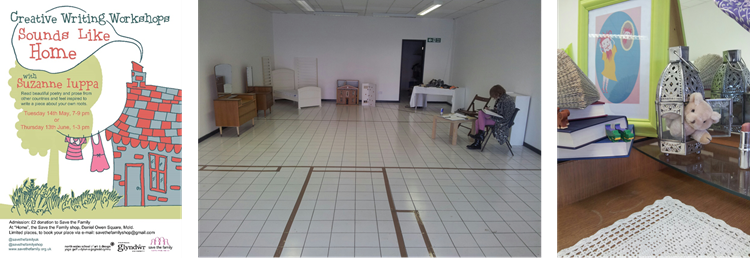
Figure 2. Left - project marketing material, Centre - shop image before, Right, shop image after.
Impact:
The project had a significant impact on all students and stakeholders involved.
Film 1. A video documenting the project (produced by www.filmage.co.uk )
For the two MA students coordinating, the project endowed them with a wealth of invaluable real-world experience, a network of arts, media and third sector contacts, greater confidence and self-belief in their abilities, and an understanding of the wide ranging applications of their own skill sets.
For students participating through volunteering, exhibiting and selling work within the space, the project presented an opportunity to gain professional experience, be part of a team, and to network with colleagues from other degree programmes, other levels of study, and professionals working within their sector.
For the charity the impact was a significant increase (over 100%) in the shops profits, far greater media coverage for the charity and it’s initiatives, and a repositioning of the charities branding and marketing going forward, with an emphasis on positivity (See figure 3 – the charity’s post project re-brand)


Figure 3. Re-brand: Top - charity's logo pre-project. Bottom – charity’s logo post-project.
For the two learners primarily involved in leading the project, it was a challenging, but rewarding experience.
It was the first time the students had to bring together such a wide range of skills into one, cohesive project. Ultimate decision making authority, the need to stick to strict time and budgetary constraints, and the fact that there were real stakes riding on every decision added an additional element of pressure, one that would not be easily replicable in a simulation setting.
The students reported that their most significant difficulties were overcoming points of contention regarding their plans with the charities own managers, and negotiating compromises where necessary, effectively managing their time with a workload of many disparate tasks, and maintaining a strong working relationship with one another, in what could sometimes be a stressful environment.
In overcoming each of these obstacles amongst many others, seeing the impact of their work, and establishing networks with a wide range of people, the overall project experience was a very positive one for the students, both of whom secured professional opportunities as a direct result of their participation.
•A team of key individuals within the institution, who can support the various aspects of project management (academic tuition / risk assessment etc.).
• A partnership with an external charity / business / community group who can benefit from student creativity and expertise.
•A nominal budget to cover any travel, subsistence and essential material costs incurred by students in project delivery.
•A project diary kept by participating student, Heather Wilson > http://missheather.co.uk/blog/tag/save-the-family
•The students’ Wordpress blog, documenting the project > https://savethefamilyshop.wordpress.com/
•A video showcase of the project, produced by www.filmage.co.uk > https://vimeo.com/66924191
•A news article on the project from www.thisproject.co.uk > http://thisproject.co.uk/articles/save-the-family-shop-home/
Group Size
?
1.) Small group (teams of 4-6)
2.) Individual Task
3.) Large Group
4.) Any
Large Group
Learning Environment
?
1.) Lecture Theatre
2.) Presentation Space
3.) Carousel Tables (small working group)
4.) Any
5.) Outside
6.) Special
Lecture Theatre
QAA Enterprise Theme(s)
?
1.) Creativity and Innovation
2.) Opportunity recognition, creation and evaluation
3.) Decision making supported by critical analysis and judgement
4.) Implementation of ideas through leadership and management
5.) Reflection and Action
6.) Interpersonal Skills
7.) Communication and Strategy
8.) Digital and Data Skills
3Decision making supported by critical analysis and judgement
4Implementation of ideas through leadership and management
5Reflection and Action
By inviting a guest speaker, typically the focus is on the animal care as the guests explore this part of their role more readily and students are most naturally interested in this. By creating a topic/challenge, you can encourage wider elements to be explored by a large group.
We have invited a range of speakers, typically from the local vet practices but also 'celebrities' such as SuperVet Noel Fitzpatrick and invited them to speak on a decision that they have had to make.
By focusing the presentation on an event or decision (ideally with costs in terms of time, resources etc) the format can be that the speaker presents a simple situation (can be a one liner) regarding a professional dilemma and the students are invited to ask questions to determine what to do in this situation. By sharing a short 'story' of an animal requiring help out of hours, with no owner, or a request to support local event (judging a dog show or running a stand) with increasing demands and no payment, or how a particular situation with escalating costs was handled, the students are invited to ask short questions in order to make their decision as to how they would approach the task.
Wider issues of cost, professionalism, ethics, PR (Public Relations) etc can all feature in the discussion.
With an invitation to a more well-known figure, a different approach can be taken, and a broad invitation across the institution and beyond be made. By creating a public event, this allows for a broader range of questions to be asked and students to mingle with externals and wider colleagues alike.
The impact of bringing external viewpoints into the traditional lecture theatre practice often creates an impact that creates a “buzz” for weeks to come.Students regularly reference the comments made by externals for weeks to come and deepen their understanding of their future careers. By sharing real-life stories, the interdependent nature of business issues and animal care is made clear to the students.
Understanding and appreciation of career options, as well as the wider context of their subject is a key lesson for most students. Ideally the week after a talk, a wider debrief (without the speaker present) is taken to explore the range of issues that the students have understood. This reflection can be particularly powerful, especially as the opportunity to hear different speakers provides different perspectives for learners to compare.
Agreement and discussion with the guest speaker – to prepare their situation and what questions they will answer and how they handle them.
http://www.enterprisingvet.com/
http://coursewareobjects.elsevier.com/objects/companion_sites/enterprisingvet/casestudies/
Henry, C (2013) Veterinary Business and Enterprise - Theoretical Foundations and Practical Cases London Elsevier
Group Size
?
1.) Small group (teams of 4-6)
2.) Individual Task
3.) Large Group
4.) Any
Any
Learning Environment
?
1.) Lecture Theatre
2.) Presentation Space
3.) Carousel Tables (small working group)
4.) Any
5.) Outside
6.) Special
Any
QAA Enterprise Theme(s)
?
1.) Creativity and Innovation
2.) Opportunity recognition, creation and evaluation
3.) Decision making supported by critical analysis and judgement
4.) Implementation of ideas through leadership and management
5.) Reflection and Action
6.) Interpersonal Skills
7.) Communication and Strategy
8.) Digital and Data Skills
1Creativity and Innovation
2Opportunity recognition‚ creation and evaluation
3Decision making supported by critical analysis and judgement
4Implementation of ideas through leadership and management
5Reflection and Action
6Interpersonal Skills
7Communication and Strategy
Student clubs and societies can be a great means for students from any level or programme of study to gain invaluable enterprise skills. Through taking responsibility for a club a society, students are required to demonstrate effective team working, excellent management skills, excellent administrative skills and financial literacy, communication and marketing skills, and must have the ability to successfully devise, plan and deliver projects and activities to keep their members engaged.
Clubs and societies can be for students from any programme of study, run exclusively for students from a particular programme, and include students, alumni, staff and members of the general public.
For the small cohort of students studying towards a BSc in Animal Studies at Glyndwr University, forming a departmental society (Zoo Soc) was an ideal way to bring the cohort together, and provide a range of extra-curricular social and learning opportunities.
In Spring 2013, students from the BSc (Hons) Animal Studies programme at Glyndwr University, approached Glyndwr University Students Guild regarding establishing 'Zoo Soc' at the institution.
The society was to cater primarily to students (at all levels of study) from the Animal Studies programme, but open to membership from staff, alumni, andstudents from any course with an interest in animals and zoology.
The students nominated a president, vice president, two secretaries and a treasurer to run the society, and promoted the new society to their peers, gaining enough support in the form of signatures to be constituted as a Students' Guild Society.
There after the students took responsibility for all aspects of Zoo Soc's management and administration. This was inclusive of promoting the society and its events, promoting society membership, conducting meetings of society members and officers, organising activities and events, and raising and managing funds. The Students Guild offered support to the students through all of these processes.
Zoo Soc's first event was a Pub Quiz, held at the University's student bar, and aimed at developing relationships between students from Glyndwr’s main campus, and its rural campus (situated approximately 20 miles away). The event was a success, and the revenue and new membership gained through the event went on to directly support future events, including trips to Zoo’s, Museums and other events.

Figure 1. Promotions poster for Zoo Soc's first event
2 year after the society's establishment, approximately 100 students are engaging with the Zoo Soc and its events, which have continued to be delivered in a professional and financially sustainable way.
For all learners who have engaged with the society, there have been countless opportunities to network, increase their knowledge, and exchange and create ideas.
For those leading the society the outcomes have been far greater, developing a broad range of enterprising skills in the process, whilst directly supporting their academic subject knowledge.
With thanks to Glyndwr University Students Guild.
Group Size
?
1.) Small group (teams of 4-6)
2.) Individual Task
3.) Large Group
4.) Any
Small group (teams of 4-6)
Learning Environment
?
1.) Lecture Theatre
2.) Presentation Space
3.) Carousel Tables (small working group)
4.) Any
5.) Outside
6.) Special
Special
QAA Enterprise Theme(s)
?
1.) Creativity and Innovation
2.) Opportunity recognition, creation and evaluation
3.) Decision making supported by critical analysis and judgement
4.) Implementation of ideas through leadership and management
5.) Reflection and Action
6.) Interpersonal Skills
7.) Communication and Strategy
8.) Digital and Data Skills
3Decision making supported by critical analysis and judgement
6Interpersonal Skills
7Communication and Strategy
THIS Project is a North Wales based social enterprise, promoting arts and culture through a wide range of services and activities, including exhibitions, concerts, training and events, the management of pop-up and semi-permanent gallery / event spaces, and providing studio spaces for professional artists. Based in Wrexham, it serves North Wales and wider region, and has a close relationship with the region’s key education and arts organisations.
This exercise saw a group of recent graduates of Fine Art (at the North Wales School of Art and Design, Glyndwr University), gain real world experience in a faced-paced, professional gallery environment. 12 student artists volunteered with THIS Project in Galeri 3B, one of its premier exhibiting venues, and over the course of three days went through the process of preparing, curating, installing and managing an exhibition within the gallery, featuring their own work and the works of fellow recent graduates.
Over a three day period in September 2014, students shadowed and supported the THIS Project team, as it went through the process of the clean down, set up and installation of new exhibition works at Galeri 3B.
The graduates worked as a team, and took responsibility for hanging their own works. Though this is something they had experience of from their University exhibitions, the challenge of working to tight time-scales, in a new environment, was one they had to successfully adapt to.
The students then prepared written statements about their works, and displayed these alongside them at the exhibition.
The main purpose of the exercise was for the Graduates to understand the importance of being able to hang their own work, have clear ideas about how they would like it to be displayed, and the ability to communicate these ideas effectively, as well as being able to communicate confidently about their own work with a variety of audiences.
We hope it gave the graduates the confidence to be able to approach other galleries in the future, and experience of how to act in a professional gallery environment.
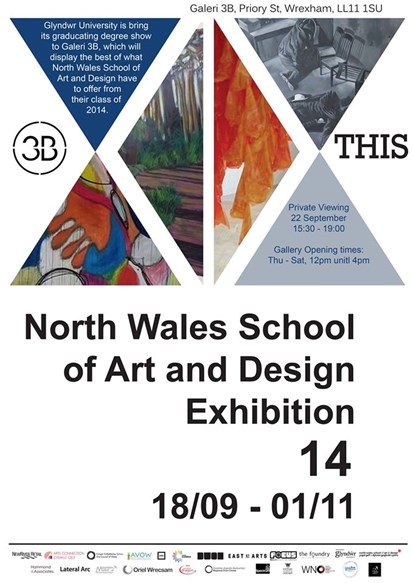
Figure 1. The students' exhibition poster
For THIS Project as an organisation, working with the graduates was a great opportunity to build networks with emerging artists, and to build connections between art students and graduates, and the general public in North East Wales. The effective display artwork is an important factor in the self-promotion of the artist, and so this was something we were keen to give students opportunities to develop their skills in.
Student Feedback Included:
“Well I was glad for the opportunity to show our work again to the public. I thought you did a good job of assisting us in organising and handling our art work. The space was excellent for obvious reasons. Yeah it was the first time I had art work in a gallery, and you offered me to volunteer at the gallery. Which allowed me to see and be a part of art events of Wrexham, and to see other working artists.”
“I would say it helped in the sense that it gave me some experience as to what it’s like to exhibit your work in an actual gallery as opposed to just in Uni, also it forced me to really think about how I should price my work and compare my decision to what others in my class priced their work and get a vague idea of how much people expect things to cost, it was also helpful and interesting to hear feedback from the general public, as their opinions were different to what some lecturers thought, and I think they tend to be more honest than when asking friends and family.”
Some of the outcomes achieved by the students involved in the project included;
References:
If you would like to have your Case Study featured, please download the template and email the completed version to hello@etctoolkit.org.uk.
We have produced a guidance sheet which will assist you in completing the Case Study.
If you have any questions regarding completing the template, please Contact Us.
If you or your students are interested in developing a business idea, becoming self-employed/freelance or creating a business here are some tools to help and also some links to business start-up support.
These guides have been selected to build QAA (2018) entrepreneurship skills in your teaching.
Group Size
?
1.) Small group (teams of 4-6)
2.) Individual Task
3.) Large Group
4.) Any
Small group (teams of 4-6), Large Group
Learning Environment
?
1.) Lecture Theatre
2.) Presentation Space
3.) Carousel Tables (small working group)
4.) Any
5.) Outside
6.) Special
Any, Special
QAA Enterprise Theme(s)
?
1.) Creativity and Innovation
2.) Opportunity recognition, creation and evaluation
3.) Decision making supported by critical analysis and judgement
4.) Implementation of ideas through leadership and management
5.) Reflection and Action
6.) Interpersonal Skills
7.) Communication and Strategy
8.) Digital and Data Skills
2Opportunity recognition‚ creation and evaluation
5Reflection and Action
This task provides an opportunity to reflect on the learning gained during particular tasks for activities (ideally should be of "medium" length, such as intense induction programmes, week long activities or longer learning 'events' (modules or years of study). This can be particularly effective in terms of drawing out "change" or learning gain as identified by the learner themselves.
This approach provides an opportunity to reflect upon a wide range of individual development (including emotional development and confidence levels) as well as recognising improvement in the development of skills.
Traditionally physical diaries were issued to encourage students to write regularly and informally, however the wide range of multi-media (through smart phones and tablets) also allows students to select their own format (s) or trial the use of a new media tool for this purpose (ideally agreed in advance with tutor to avoid IT issues in viewing).
A learning diary is therefore a tool of reflection which can take a variety of forms.
Key considerations for the tutor include:
NB: Consideration of how to create "value" is key in determining the role/purpose of this approach within an assessment strategy or within a programme. Typically students value activities that the tutor places a value on, and their currency is marks/assessment. However as diary is, by definition, a subjective view, and should reflect what the student has heard, learnt and reviewed, it is the student's own analysis and insights that count, and clear marking parameters and guidance need to be provided to ensure clarity.
Issuing this task should be done at the start of the activity that you wish the learners to reflect upon. Ideally you encourage (or set) answering a range of open-ended questions, delighted to understand their initial position as they approach this learning/task. This may include expanding upon their prior understanding or life experience, as relevant to this work.
Once the activities are being undertaken, reflective models can be issued or sourced by the students to support their thinking. However you may wish to provide a set of reflective questions at regular intervals as prompts to their developing thinking.
This activity can be highly prescriptive, with set timescales at which you expect stages of reflection to be completed (as relating to the task being undertaken) however it is also possible to make this an open task, where the approach and learning is with the student to design and undertake. This allows the learner to explore, source and select their own model for reflection and test its effectiveness as a tool for their development during the process. This additional skills of research, evaluation and comparative analysis but risks diluting the quality of the reflection if the students place the emphasis upon critiquing models rather than the task itself and their personal learning. It is therefore important that you reflect the emphasis you wish to seek within your assessment schedule.
To increase the synthesis, and the ability for personal and confidential reflection, you may wish to create a format in which the students regularly capture thoughts and feelings, but keep this as a personal document (diary, blog or video diary) from which the submission is created. This synthesised version of their learning and reflections build an understanding of their personal development over time and allows for honest and uncensored self-reporting and reflection. Again the structure/control of the format/questions can be loose and open (providing only sources and reference to guide) or highly prescriptive (working within a template or with specific tools/questions) to ensure that the key elements of learning (including emotional elements and confidence) are a required feature of the submission.
Personal reflection is a tremendous skill, but is often difficult for students to develop, particularly during a period of study, with little or no external reference points or practical application. It is therefore recommended that this is an assessed piece, so that the value of reflection is made clear. It is therefore important that you, as the tutor, place importance upon the development of this skill and take class-time to consider what is meant by reflection practice and how to ensure that reflection leads to learning.what is meant by reflective practice and how to ensure that reflection leads to learning. It is also important to consider the formative as well summative assessment within this process, as reflective skills are improved through regular practice, and this form part of your regular teaching. It is important that you 'model' a reflective approach with the students by including reflective questions onto your regular contact with them, and making reflection an explicit aspect of your activity/classroom debrief. Making this explicit within your teaching will reinforce the student's understanding of reflection as an activity to repeated and practiced, as well as help them see how reflective questioning or models can deepen their understanding, and build confidence in their abilities.
Three stem questions (Borton T 1970) were further developed by John Driscoll (1994, 2000, 2007)
Group Size
?
1.) Small group (teams of 4-6)
2.) Individual Task
3.) Large Group
4.) Any
Individual Task
Learning Environment
?
1.) Lecture Theatre
2.) Presentation Space
3.) Carousel Tables (small working group)
4.) Any
5.) Outside
6.) Special
Any
QAA Enterprise Theme(s)
?
1.) Creativity and Innovation
2.) Opportunity recognition, creation and evaluation
3.) Decision making supported by critical analysis and judgement
4.) Implementation of ideas through leadership and management
5.) Reflection and Action
6.) Interpersonal Skills
7.) Communication and Strategy
8.) Digital and Data Skills
3Decision making supported by critical analysis and judgement
4Implementation of ideas through leadership and management
Construct and deliver a focused and precise summary of their business proposal, that is attractive and engaging to a potential financer.
Prepare the entrepreneur for opportunities to present their business proposal, formally and informally, in a short space of time.
An ‘Elevator Pitch’ is a succinct summary of business opportunity for example, 1 minute or in no more than 300 words. The term is typically used in the context of an entrepreneur pitching an idea to a potential investor. This task invites the student to prepare for a minute pitch.
Invite the entrepreneur/small business owner to prepare a 3 minute pitch for their business The challenge for many entrepreneurs is how to describe their proposal in such a short space of time and what aspects of their business model and plan to focus on. A useful approach is to use Sahlman’s recommended four critical factors.
The People
Who’s involved?
What are their mission and aspirations?
What skills, know-how and experience do they have?
The Opportunity
What will the business sell?
Who are its customers?
What problem is it solving?
Why is it better than existing solutions (competition)?
The Context
What’s the bigger picture?
What trends e.g. economic, social, technological, political affect the business?
Risk and Rewards
What are the main risks?
How can they be mitigated?
What are the potential financial, and other, rewards?
Entrepreneurs/small business owners should be given time to prepare their pitch, either working independently at home or within a training programme. In a group situation this should take no more than 20 mins.
Entrepreneurs should then be invited to pitch their business with a strict time limit. This can be done in a number of ways depending on the environment, for example,
This activity helps the entrepreneur to focus how they think about their business and provides a safe environment in which to develop their communication and presentation skills, whilst refining their business pitch.
It can help the entrepreneur /small business owner effectively present their business proposal in both informal and unexpected situations and confidently to a potential financier. Repetition of this type of exercise builds confidence and expertise.
To provide formative experiences of pitching, before any assessment, you can create sub-groups within which the students pitch to each other, giving and receiving constructive criticism, before conducting the final presentation.
Group Size
?
1.) Small group (teams of 4-6)
2.) Individual Task
3.) Large Group
4.) Any
Small group (teams of 4-6), Individual Task
Learning Environment
?
1.) Lecture Theatre
2.) Presentation Space
3.) Carousel Tables (small working group)
4.) Any
5.) Outside
6.) Special
Carousel Tables (small working group)
QAA Enterprise Theme(s)
?
1.) Creativity and Innovation
2.) Opportunity recognition, creation and evaluation
3.) Decision making supported by critical analysis and judgement
4.) Implementation of ideas through leadership and management
5.) Reflection and Action
6.) Interpersonal Skills
7.) Communication and Strategy
8.) Digital and Data Skills
2Opportunity recognition‚ creation and evaluation
3Decision making supported by critical analysis and judgement
4Implementation of ideas through leadership and management
5Reflection and Action
This activity is designed to provide an opportunity for the entrepreneur/ small business owner to consider the costs of setting up a new business and the financing options available.
Does the entrepreneur/ small business owner already have some equipment or stock etc. that can be used in the business? What additional start-up costs will be incurred in order to successfully start the new venture?
This can be broken down into:-
Once the above Start-Up costs have been completed, it is only then that the Financing can be considered. If the start-up costs are higher than at first anticipated, it may be that the new business owner needs to re-evaluate these costs. For example, consideration of renting items of equipment instead of buying etc.
Financing the new business start-up.
What if things change and I need additional funding? As long as the new business owner can demonstrate that they are running the business well, they may be able to access further finance to assist their growth plans. This is why it is so important to have a good business plan and to monitor how well the business is actually performing compared to the plan.
By developing analytical and financial forecasting skills within entrepreneurial learners, it is possible to test assumptions and explore alternative ‘what-if’ scenarios in the context of a business start-up.
This breaks down some of the key thinking and skills of the entrepreneur and allows the students to work through their assumptions. This can be conducted in groups, or as individuals, allowing students to focus on start-up.
Group Size
?
1.) Small group (teams of 4-6)
2.) Individual Task
3.) Large Group
4.) Any
Any
Learning Environment
?
1.) Lecture Theatre
2.) Presentation Space
3.) Carousel Tables (small working group)
4.) Any
5.) Outside
6.) Special
Any
QAA Enterprise Theme(s)
?
1.) Creativity and Innovation
2.) Opportunity recognition, creation and evaluation
3.) Decision making supported by critical analysis and judgement
4.) Implementation of ideas through leadership and management
5.) Reflection and Action
6.) Interpersonal Skills
7.) Communication and Strategy
8.) Digital and Data Skills
2Opportunity recognition‚ creation and evaluation
4Implementation of ideas through leadership and management
5Reflection and Action
6Interpersonal Skills
7Communication and Strategy
An elevator pitch (EP) is becoming an important item in the toolkit of most people. It doesn’t matter if you are a job seeker, business person, or gainfully employed professional, you need a powerful elevator speech (EP) to extend and support your personal brand.
Activity:
PART 1: Using a flip chart, PowerPoint or workbook the tutor will take the individual or the group through the key points of elevator pitches.
Make them care
The main mistake many people make when pitching is listing their products and services and go into detail about processes. People want to know how you can help them, or solve a problem they have. Emphasise benefits and solutions rather than features.
Your Second Word Should Be A Verb
What do you do? For others? This also forces you into thinking about your results and accomplishments. Get a list of powerful verbs, look them up.
You Have To ‘Get’ What’s Unique About You and Your Business
What differentiates you, what causes you to stand out from the competition? This is what you want in your elevator pitch.
A Few Sentences Is Usually Enough
Think short and sweet. Powerful is not lengthy or full of too many words. When you force yourself into a few sentences, it causes you to think about each word more carefully so that each one tends to convey more.
It Has To Roll Off Your Tongue
You need to write it down and practice it so it becomes second nature to you. This will support a confident appearance when you say it.
You Have To Believe It
If you develop an EP that embarrasses you or causes you to cringe, you either need to boost your confidence or change what you’re saying about yourself.
Give It Attitude
If your EP doesn’t have energy or enthusiasm, then expect it to be received the same way. We like people with confidence and a bit of attitude about their abilities. You’re not bragging, but proud.
Smile
It’s hard not to love people who smile. It communicates warmth and confidence. You come across as engaging and someone people would like to know more about.
Shut Up
Once you’ve delivered your EP, stop yourself from saying anything else. I know this is a tough one, but people often blather on, which deflates the impact of your ES. When you stop talking, it will also prompt the person you are introducing yourself to to ask about you or introduce themselves. Both results are great.
Leave Them Wanting More
A great test of a powerful EP is if they ask you about what you’ve just said. Go have fun with this. Next time you attend a professional meeting, say your EP, shut up and see what happens.
Have A Few EP’s In Your Toolkit
EP’s are not one size fits all. Your audience will be a determining factor in whatspecific message you want to convey. Different aspects of your products or services will appeal to different people and companies
Once you have your primary EP, think through the various groups of people you are likely to use it with. This will help you decide what needs to get tweaked to make it just right for that group of people.
Your elevator pitch is among the first things you do that will form an impression with others. You want it to be professional and well delivered.
PART 2: Each member of the group has 10 minutes to devise their own elevator pitch.
PART 3: Each member of the group delivers their elevator pitch with the tutor and the rest of the group giving feedback and suggestions for improvement.
PART 4: This can be developed further by videoing each person so they can see for themselves.
Planning, preparation, presentation, feedback review, reflection
Group Size
?
1.) Small group (teams of 4-6)
2.) Individual Task
3.) Large Group
4.) Any
Any
Learning Environment
?
1.) Lecture Theatre
2.) Presentation Space
3.) Carousel Tables (small working group)
4.) Any
5.) Outside
6.) Special
Lecture Theatre, Presentation Space
QAA Enterprise Theme(s)
?
1.) Creativity and Innovation
2.) Opportunity recognition, creation and evaluation
3.) Decision making supported by critical analysis and judgement
4.) Implementation of ideas through leadership and management
5.) Reflection and Action
6.) Interpersonal Skills
7.) Communication and Strategy
8.) Digital and Data Skills
1Creativity and Innovation
2Opportunity recognition‚ creation and evaluation
5Reflection and Action
A well-structured, well-research and well-written business plan is an invaluable asset to any new enterprise. Yet many students considering starting up report difficulty in developing business plans and in particular, plans which actively work for them and their business.
Business Planning is a workshop serving as an introduction to the subject, inclusive of opportunities to reflect on skills and generate ideas, and information regarding how to build a strong and cohesive plan around those ideas, and advice regarding using that plan, to turn those ideas into successful businesses.
The activity is designed to fit within a typical one hour lecture session, but inclusive of ample opportunities for extension, through practical activity, group discussion or independent research, and could easily form the basis of a more comprehensive scheme of work on the subject. It is designed to be appropriate for students of any level or programme of study. It was originally developed through the HEFCW funded pan-Wales Enterprise Support Programme.
Lesson plans and AV presentations for use in the delivery of the workshop can be downloaded via the link to the ‘ZONE Enterprise Hub’ webpages listed in ‘References’ and ‘Resources.’
The activity follows the structure outlined in the ‘Business Planning’ PowerPoint presentation, inclusive of all links and examples.
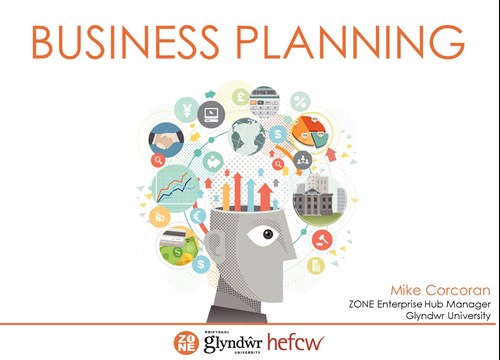
Figure 1. PowerPoint presentation which accompanies this activity.
Pre-Activity
Students are not required to prepare anything in advance of this workshop. For workshop leaders, preparation is minimal, other than ensuring supporting AV resources are displaying correctly.
Introduction
Why Bother?
What to think about?
What to write down?
Help and support
Students are provided with links and information regarding the support, advice and assistance available to them as they develop their business plans.
Conclusion
The key themes covered in the workshop are re-capped, and students are invited to ask any outstanding questions which they may have.
Post-Activity
This workshop is intended only as an introduction to the subject of Business Planning. Following the activity, students may utilise the information provided to research and develop their plans independently, or each element of the workshop may be revisited and explored in more depth by the group.
Students will leave the workshop with greater confidence in their ability, with a better understanding of their skills, and how these skills will support the development of their endeavours. They will have a better knowledge and understanding of business plans and how to develop them, and a greater awareness of how to use business plans to effectively support them in their endeavours.
Resources:
PowerPoint Slides accompanying this activity can be downloaded here > Business Planning [PDF]
Zone Enterprise Hub, Topic: ZONE Resources. 2015. [ONLINE] Available at: https://moodle.glyndwr.ac.uk/course/view.php?id=37§ion=11 . [Accessed 05 August 2015].
Group Size
?
1.) Small group (teams of 4-6)
2.) Individual Task
3.) Large Group
4.) Any
Small group (teams of 4-6)
Learning Environment
?
1.) Lecture Theatre
2.) Presentation Space
3.) Carousel Tables (small working group)
4.) Any
5.) Outside
6.) Special
Presentation Space
QAA Enterprise Theme(s)
?
1.) Creativity and Innovation
2.) Opportunity recognition, creation and evaluation
3.) Decision making supported by critical analysis and judgement
4.) Implementation of ideas through leadership and management
5.) Reflection and Action
6.) Interpersonal Skills
7.) Communication and Strategy
8.) Digital and Data Skills
1Creativity and Innovation
2Opportunity recognition‚ creation and evaluation
6Interpersonal Skills
Objectives:
These are the learning outcomes for the session and are outlined to participants at the start of the activity.
Overview:
This activity was developed to stimulate the entrepreneurial competencies of ‘creativity’ and ‘opportunity recognition’. Creativity and Opportunity recognition have been recognised as essential elements of the entrepreneurial process (Morris et al; 2013) and skills that enterprise educators should be developing with their students (QAA, 2018). In recognition that entrepreneurial activity requires collaboration with others, the exercise was also designed to be conducted with small groups thereby targeting the development of participants’ team working skills.
Students are given a range of ‘low value’ items and they must work in small groups to brainstorm new products and services that utilise the original item but produce greater value. This is a non-assessed activity.
Activity: Total time – 2.5 hours
(1st hour) – The educator uses a short powerpoint to outline to the entire group the objectives of the session (listed above). It is stated that these are the Learning Outcomes expected for the session and the activities undertaken are designed to give students the opportunity to meet the Learning Outcomes thereby demonstrating constructive alignment (Biggs and Tang, 2011).
In small groups of 4-6, students are given at least three items that have been bought from the pound shop. These items are unbranded, unlabelled and the current use of these products is not revealed to the students who can only guess at the items uses. Students are asked to use their creativity to list as many possible uses of each item in turn. They may also consider what new products or services may be produced by combining items. The educator will go round each group in turn using prompting questions to stimulate discussion. If a group appears ‘stuck’ for ideas, the educator will encourage them to play with the items and use all their senses to examine the items. The educator could also bring in additional resource such as business planning boards to aid discussion (see photos)
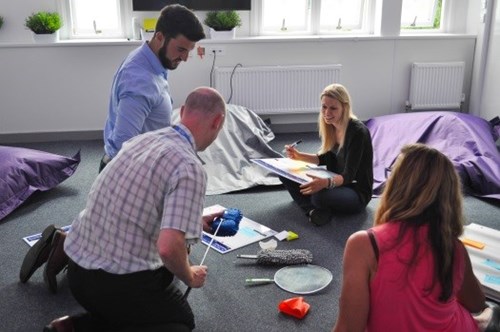
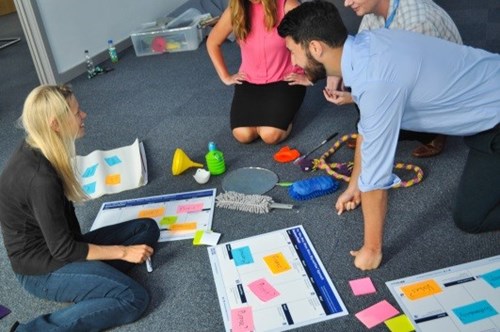
(2nd hour) The educator will signal that the ‘brainstorming’ phase of the task is over and now groups must decide on a final idea and begin to assess the commercial viability of their idea. Groups will use paper/whiteboards/ipads to begin sketching a prototype of their final idea with key information such as; product/service description, intended target market, intended pricing. The educator again circulates round the groups asking prompt questions and checking group progress. The educator gives each group formative feedback on their idea as the activity progresses.
(final 30 minutes) Each group will take turns to present their drawings and discuss their final idea with the whole group. The educator will provide feedback on each groups’ idea, particularly on any innovative aspects and commercial viability. Groups will be invited to comment on other groups’ ideas and to make suggestions for any additions or improvements.
Extensions – This activity can be extended to include a panel of industry experts. After groups have presented to one another and received educator and peer feedback, they can then prepare a final pitch to a panel of individuals drawn from relevant industry sectors thereby receiving ‘real world’ feedback on their ideas.
Assessment – this is a non-assessed activity and is designed to enable students to practice their creativity skills and opportunity recognition outside of the potential pressures of an assessed environment. It is an activity conducive to an environment of collaboration and discussion rather than competition and criticism.
Options for delivery – ideally this exercise would be undertaken in a physical space that is conducive to creative thought and action. For example a room with movable furniture, adjustable lighting, stimulating imagery or colours on the walls, or outside where the environment can interact with the chosen items.
Skill Development
Resources:
References:
Biggs, J. and Tang, K. 2011. Teaching for quality learning at University. 4th ed. Maidenhead: Oxford University Press.
Morris, M. Webb, J. Fu, J. and Singhal, S. (2013) A Competency-Based Perspective on Entrepreneurship Education: Conceptual and Empirical Insights, Journal of Small Business Management, Vol. 51, No. 3, pp. 352–369.
Quality Assurance Agency (QAA) (2018) Enterprise and entrepreneurship education. Guidance for UK higher education providers, The Quality Assurance Agency for Higher Education: London.
If you would like to have your How to Guide featured, please download the template and email the completed version to hello@etctoolkit.org.uk.
We have produced a guidance sheet which will assist you in completing the How to Guide.
If you have any questions regarding completing the template, please Contact Us.
Group Size
?
1.) Small group (teams of 4-6)
2.) Individual Task
3.) Large Group
4.) Any
Large Group
Learning Environment
?
1.) Lecture Theatre
2.) Presentation Space
3.) Carousel Tables (small working group)
4.) Any
5.) Outside
6.) Special
Any
QAA Enterprise Theme(s)
?
1.) Creativity and Innovation
2.) Opportunity recognition, creation and evaluation
3.) Decision making supported by critical analysis and judgement
4.) Implementation of ideas through leadership and management
5.) Reflection and Action
6.) Interpersonal Skills
7.) Communication and Strategy
8.) Digital and Data Skills
2Opportunity recognition‚ creation and evaluation
7Communication and Strategy
Ned Snogard (Dragon’s Den in reverse) tasks business experts to pitch fictitious business ideas to students. The session aims to help students to understand the art of pitching and securing funding for new business ideas. This has been delivered with HND Business and Enterprise Year 2 but would work with any group working on entrepreneurship and could use themed (subject-related examples).
Time required 1:30 – 2 hours.
Pre-session: Entrepreneurs are invited to take part in the event and are given the chance to pick from a list of fictitious business scenarios or come up with one of their own. Their task is to prepare a 5 minute funding pitch to an audience of students and then be questioned by the students for an additional 5 minutes.
In this case study the ideas included iBooze, an iPhone app which turns a phone into a breathalyser, To Dye For, a clothes up-cycling business, and Silky Road Tyres, a new composite tyre formula using traditional rubber combined with recycled materials to produce a tyre which reduces road noise and fuel consumption.
The winning pitch can be decided through a show of hands, cheering the loudest for the preferred pitch or if time/space permits allowing the students to decide as a group and a nominated student feeding back the pros and cons of each pitch and why the winning pitch was chosen as the one they would be most likely to invest in.
The entrepreneurs are given time to confer which they felt was the most relevant and insightful question of the session. The winning student is presented with a gift voucher or other small prize.
Finally it is revealed to the students during the round up session that the business ideas are fictitious – which so far has been a complete surprise to the students, further embedding the importance of confidence.
Paul Peachey: “We initially trialled Ned Snogard as an extra-curricular activity, it will now run annually as part of the undergraduate degree programme. The students were stunned at the event when it was revealed that none of the ideas were real – demonstrating the polished pitching skills of the entrepreneurs.
Emma Forouzan, Enterprise Start-up manager at the University, said: “This is the second Ned Snogard event we have run at USW and it provides a fantastic learning opportunity for our students to take the seats of the Dragons and learn from the pitches of real entrepreneurs. We were all impressed by the quality and range of the questions from the students – they didn’t hold back in asking tough questions.”
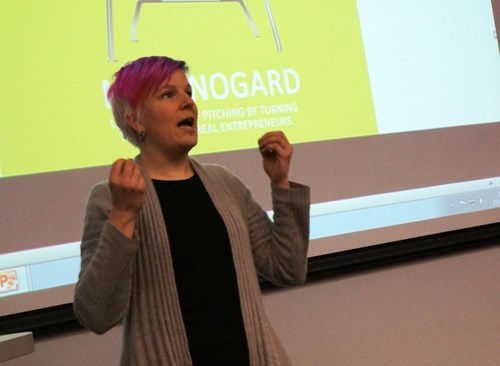
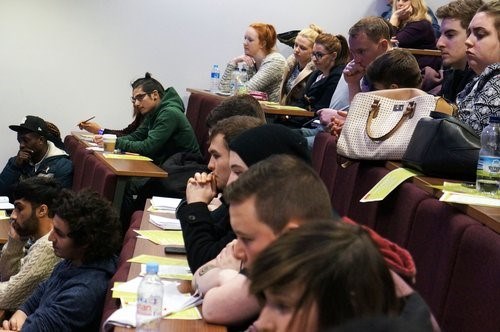
http://www.southwales.ac.uk/news/2015/ned-snogard-turns-tables-dragons/
Key authors: Idea originated by Stuart Miller of Bybox
Group Size
?
1.) Small group (teams of 4-6)
2.) Individual Task
3.) Large Group
4.) Any
Small group (teams of 4-6)
Learning Environment
?
1.) Lecture Theatre
2.) Presentation Space
3.) Carousel Tables (small working group)
4.) Any
5.) Outside
6.) Special
Carousel Tables (small working group)
QAA Enterprise Theme(s)
?
1.) Creativity and Innovation
2.) Opportunity recognition, creation and evaluation
3.) Decision making supported by critical analysis and judgement
4.) Implementation of ideas through leadership and management
5.) Reflection and Action
6.) Interpersonal Skills
7.) Communication and Strategy
8.) Digital and Data Skills
1Creativity and Innovation
4Implementation of ideas through leadership and management
6Interpersonal Skills
7Communication and Strategy
This case study describes a speed networking event that enables 1st years Computing and Business students to engage with Level 6 students in ‘live’ projects.
Level 4 student teams compete for business opportunities by attending a networking fair and engagement with level 6 students. The task is supported by in-class activities, but the emphasis is on learning by doing. Students are encouraged to reflect on the experience as part of the assessment strategy.
Participation at the event forms part of both year group’s module assessment. At the beginning of the academic year, final year student teams identify a year long project opportunity. They meet the client and develop a project to deliver to them. In the 2nd semester, Level 4 student teams are introduced to key concepts of business development and prepare to engage with Level 6 students at the speed networking event. In preparation for the event, Level 6 groups prepare project briefs. These briefs create a ‘mini’ market place for Level 4 groups to segment and target based on their own team goals. Typically, the students work in teams of four. After the Speed Networking event the teams from level 4 and 6 work together to complete their part of the project.
Specifically, students at level 4 prepare by developing an understanding of the start up business cycle. Such as team formation, start up strategy and product/ service development. Students are given prior knowledge of potential projects, which helps them target their pitch and brand. They learn to create rudimentary business artefacts such as a brand name; business cards and a sales pitch (see photo attachment). Students were also guided on networking skills, such as body language and professionalism.
Students at Level 6 prepare by developing a project plan with their project client. During the delivery phase of the project. They identify an outsourcing opportunity and produce a project brief, roughly 1 month in advance of the event. A pro-forma is provided to create a consistent look and feel to each teams brief, so that level 4 students can easily assess the merits of each potential project brief (see attachment). Around 20 projects are created by the cohort, which roughly matches the number of teams at level 4. The supply of projects can be increased by Level 6 students creating more than 1 outsourcing project. Projects range from simple tasks, such as logo design to more complex projects, such as research, web development, and media production.
The project clients are typically from external organisations, such as charities and local businesses, but can be internal clients, such as, as tutors. Project size for level 6 students should be complex enough too ensure that the challenge provides adequate work for each team member. The sub task project for Level 4 can be relatively simple. It is more essential to engender confidence and good team work at Level 4.
The competitive nature of the event means that teams are not guaranteed to get what they want. Success is often determined by the quality of planning carried out in advance of the fair, or by the professionalism of the team on the day.
The event is very popular and student engagement in the event is close to 100%, with around 150 participants. While conducting the task, students have very little time to become distracted, which means that they receive the full benefit of the session.
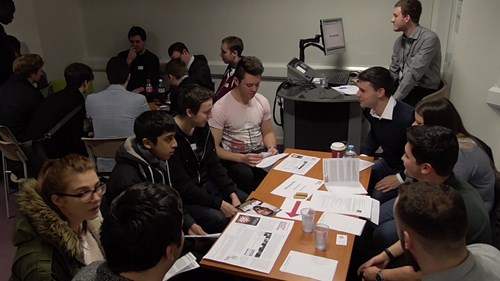
Student feedback comments are also very positive:
Verbal and scored Feedback
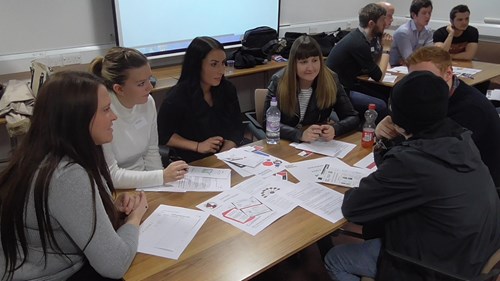
National Student Survey feedback comments single out the modules as a key benefit from the course.
“I really enjoy this course, as it's stimulating and pushes my boundaries. I have noticed vast improvements in my abilities, in terms of communication, presenting and teamwork. All staff are very helpful in terms of problem solving and it's nice to know that the support is there when needed. I enjoy the course content and how interactive the course is.” NSS 2015
“The course really targets employability and it really appeals to employers that we gain hands-on business skills.” NSS 2015
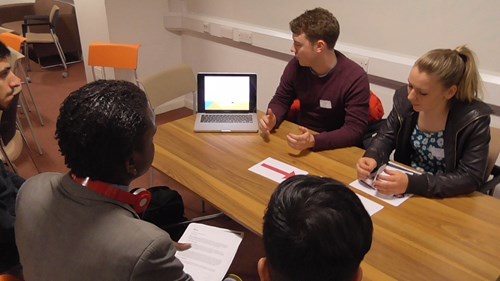
Students learn the benefit of planning and preparation. They also understand that it is difficult to communicate in a time pressured environment. An interesting side effect of the event, is that students in level 4 can benefit from a peer mentoring experience; learn about the course and how to be successful at gaining a placement. The event is also a novel learning experience and adds a new dimension to the university experience. Final year students benefit from the reflection of ‘how they used to be’, which adds to their confidence.
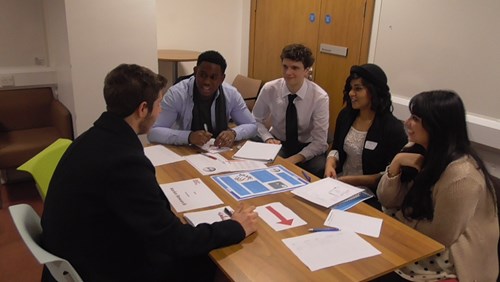

Contact details: Dr Andrew Hirst, Teaching Fellow in Work Based Learning, Sheffield Hallam University https://www.linkedin.com/in/drandrewhirst
If you would like to have your Case Study featured, please download the template and email the completed version to hello@etctoolkit.org.uk.
We have produced a guidance sheet which will assist you in completing the Case Study.
If you have any questions regarding completing the template, please Contact Us.
If you are seeking to create a programme of extra curricula activities or an intensive summer school/bootcamp, then you might wish to consider using guest speakers, such as Alumni.
For more ideas and support for using externals, search for speakers, panels and alumni within the ETCToolkit for further ideas.